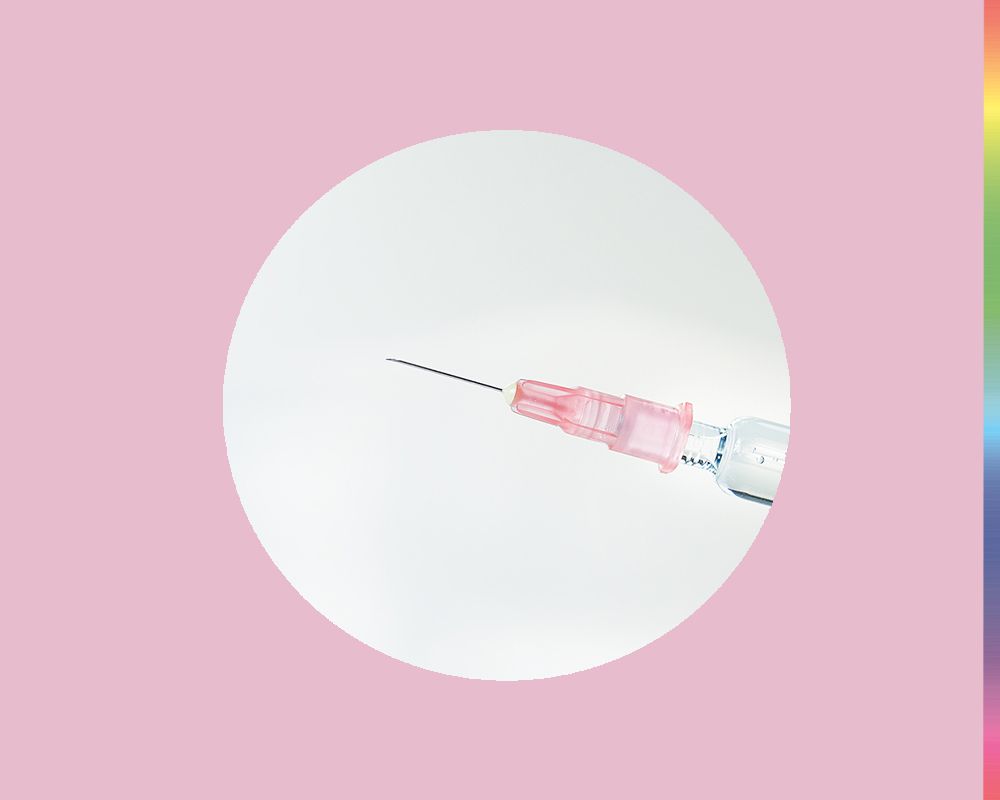Here’s Why Everyone Is Using NuFace Again
There was a time not too long ago when I unceremoniously unloaded three years’ worth of fairly expensive skincare devices onto family and friends. While I told myself it was simply the byproduct of a decluttering rampage, in reality, it was probably just sheer disillusionment: I had spent more hours than I’d care to admit under LED face masks that promised to even out my skin tone, trying to shock my dark circles into obedience with a miniature laser, and pressing battery-powered “infusers” into my skin, since they would allegedly help my products absorb better.
While I’m sure a handful of these gadgets delivered at least some of the results they marketed, I reached a point where I couldn’t be bothered to put in the work they required—especially if I wasn’t seeing a major difference in the mirror. So I left that sleuthing up to the eager hands I passed them along to, and held onto only a few trusty favorites: my derma-planing tool, my jade roller… and curiously, a NuFACE Trinity microcurrent device ($325) that had been collecting dust at the back of a dresser drawer. It was kind of my OG skincare device; the one that launched a dozen, all clamoring for real estate on my vanity. And for some reason, I felt like I owed it a fair shot before I KonMaried it away.
Microcurrent Treatments
At-home microcurrent treatments and devices use very, very small electrical currents that are meant to stimulate your facial muscles to give you a more firm and contoured appearance.
As fate would have it, a few weeks later, I stumbled onto a beauty profile of Laurel Pantin, the Fashion Features Director of InStyle who happens to have an impeccable complexion. A cornerstone of her skincare routine? That would be the NuFACE, which she credits for a more sculpted look. A few weeks after that, my friend/human skincare encyclopedia Charlotte Palermino began talking about her love of NuFACE on her Instagram stories. As I watched her point out cheekbones that were more prominent than ever, I plugged in my NuFACE for the first time in three years.
NUFACE MICROCURRENT FACIAL DEVICE
BEST FOR: All skin types
USES: Reduces puffiness, fine lines, and wrinkles, increases firmness and tone in the skin
STAR RATING: 4.5/5
POTENTIAL ALLERGENS: None
PRICE: $325
ABOUT THE BRAND: NuFACE was founded by microcurrent aestheticians and mother-daughter duo Carol Cole and Tera Peterson. The brand specializes in at-home microcurrent devices that target and treat puffiness, fine lines, and loss of elasticity.
The Design: Smooth and Compact
The NuFACE Trinity Facial Toning Device is not as large as I imagined a product like this would be. It fits neatly into the palm of your hand and is smooth to the touch. It comes with a charging cradle where you keep the device on at all times and has a battery life of about two weeks.
It comes with the Facial Trainer attachment, but if you want to switch it up, there are other attachments you can buy to target specific areas. There’s the ELE Attachment ($149) that targets the eyes and lips and the Trinity Wrinkle Reducer ($149), a powerful red light attachment meant to decrease fine lines and wrinkles.
The Feel: Gooey and Smooth
The device comes with the NuFACE Gel Primer, a gooey primer that helps conduct the microcurrents. It feels like a thick gel, but it spreads easily across the face. As for the actual device, it doesn’t hurt at all. You actually don’t feel a thing except it gliding along the “goo.” If you find yourself feeling little electric tingles on your skin, you’ll need to apply more of the Gel Primer.
How to Use: Easy and Intuitive
You can use the NuFACE Trinity during your morning or nighttime routine, but the most important thing is that your skin is clean and dry. Next, you’ll want to spread a thick, face mask-like layer of the NuFACE Gel Primer (it’s included in the price and packaging of the product) to all the areas of your face and neck that you plan on using the device. Turn the Trinity on and with light to medium pressure, press it against your face and glide in an upward motion. Repeat this motion all over the places you want to target for five minutes. After you finish, you can massage the gel into your skin or rinse off and continue with the rest of your skincare routine. For the first 60 days, you’ll want to use it everyday for five minutes for the best results.
The Science: What is Microcurrent?
Let’s talk about how NuFace actually works. For starters, the microcurrent technology it uses isn’t exactly groundbreaking in expert circles. “Microcurrent devices such as NuFace are inspired by professional EMS (electric muscle stimulation) machines that have been used on the face and body by professionals for decades,” notes Rouleau. “For the body, EMS is used in physical therapy centers to rehabilitate muscles for partially or totally immobilized patients (such as from broken limbs or paralysis) to create strength.”
Microcurrent devices such as NuFace are inspired by professional EMS (electric muscle stimulation) machines that have been used on the face and body by professionals for decades.
And the face? “They give the look of more prominent cheekbones and tighten up the look of saggy jowls,” she says. “In addition, it can help visibly plump out lines and wrinkles to a certain degree.”
By sending (tiny) electrical currents through your skin, these treatments stimulate the muscles underneath—essentially “working them out.” In other words, imagine the muscles beneath your cheekbones and along your jawline doing a ton of tiny sit-ups. When they begin to tone up, your face may take on a more sculpted look.
The caveat with sit-ups, of course, is that you need to keep doing them to maintain your results. “If you stop using it, the muscles will return to their original state,” says Rouleau. And with at-home devices that generally offer a milder variation of a professional treatment, consistency is even more important: NuFace recommends using its Trilogy device for five to 20 minutes per day, five days a week.
The Results: Sculpted cheekbones
It only took a few sessions with my Trinity to realize how much I really looked forward to the soothing massage along my cheekbones and TMJ-addled jaw. This alone ended up being the perfect carrot to lure me through a few weeks of daily use—when, while taking selfies for another story, I realized that my cheeks looked suspiciously high and sculpted; my nasolabial folds had all but disappeared.
It was when the vague compliments began pouring in—the “I can’t tell what’s different but you look great” varietal that we beauty editors view as our holy grail—that I realized I had been sleeping on a really great thing this whole time.
And I’m still not entirely positive why that is. It’s not for lack of expert endorsement—Renée Rouleau is one of several high-profile estheticians and makeup artists who have attested to the virtues of NuFace, joining the ranks of Bobbi Brown and Joanna Vargas.
But perhaps in the face of a skincare marketing landscape that grows more cluttered with hollow promises by the second, what I really needed was the assurance that my Trinity was really an outlier—that, as Rouleau mentioned, I’d find the results to be worth the time spent pressing the device into my skin every morning. Either way, I’ll just say this: Despite several years of sheer ignorance that stood in our way, my cheekbones and I are happy to finally be here.
The Value: NuFACE vs. Injectables
The best way to determine the value is to compare to injectables and fillers. To me, this is a key comparison—namely because the results I’ve seen from my NuFace rival that of filler and Botox. While in my experience, well-placed filler is quite effective, the upkeep is also wildly expensive. So it was quite exciting to notice a sharper jawline after a few weeks of using my NuFace every morning—an effect I hadn’t seen since I stopped getting Botox in my jaw. And during a recent appointment for cheek filler, I was shocked when the practitioner only used one syringe of product—exactly half of what I had used the last time I got it done a couple of years prior. I’d say $325 is a great price to pay for the device, considering Botox is anywhere between $200-$400 and the average cost of fillers is about $700.
Similar Products: You have options
Foreo BEAR™ Facial Toning Device: The BEAR™ is a slightly larger, slightly cheaper ($299 to be exact) microcurrent device. It has a brand exclusive anti-shock system that automatically adjusts the currents strength based on the part of your face you’re using it on. Technology at its finest, folks.
ReFa S Carat: While the S Carat ($160) is not a microcurrent device, it delivers similar results by copying the same massaging techniques that facialists and aestheticians use. All you need to do is gently roll the device over your face and watch your skin firm up over time.
Our Final Verdict: Time or Money?
The bottom line: I’m a big fan of any device that allows me to take a measured approach to the more invasive parts of my routine—in the faceoff between time and money, I’ll take the five minutes of daily NuFace-ing if it ultimately means a heavy discount on injectables. But that might not be true for everyone. “My general belief is that with anything in life, you have to determine where your time is best spent,” says Rouleau. “Time is a limited resource, so you want to spend it wisely and this is certainly the case when deciding whether or not you should invest energy into using a skin device at home.”










